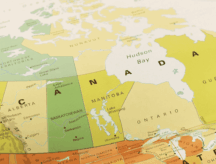Canada’s economic immigration system a ‘role model’ among OECD countries
Canada’s economic immigration system is the “most carefully designed” among the Organization for Economic Development and Cooperation’s 36 member countries and serves as a role model for those looking to improve how they manage migration, the Paris-based organization says.
According to a new report, Canada has the “largest, longest-standing and most comprehensive and elaborate skilled labour migration system in the OECD,” whose members include Australia, France, Germany, the United Kingdom and the United States.
The report commended Canada for its success in the realms of attraction, selection, integration and retention of economic immigrants and for promoting a "whole-of-family approach" that takes into account the needs of all family members — not just the principal applicant.
Among other strengths, Canada builds on “a welcoming host society, which considers immigration as a part of its national heritage,” the report says.
'Improvement based on solid evaluation and research'
At a gathering to unveil the report in Toronto, Thomas Liebig, a senior immigration specialist with the OECD, said the independent assessment of Canada’s economic immigration system is the tenth in a series of reviews performed by the OECD.
“So, Canada is not the only country we have done, but clearly Canada stands out for a number of reasons,” he said.
Top of mind for Liebig was Canada’s “constant drive for improvement based on solid evaluation and research.”
Liebig said this is most apparent in its approach to the Express Entry system, which manages the pool of applicants for three of Canada’s principal economic immigration programs — the Federal Skilled Worker Class, Federal Skilled Trades Class and Canadian Experience Class.
The report calls Express Entry “the most elaborate selection system in the OECD,” one that allows for “a more refined selection of labour immigrants than in peer countries.”
Liebig said Canada's Express Entry system serves as a "role model" for managing economic migration that many OECD countries look to for guidance.
Find out if you are eligible to enter the Express Entry pool
Since its introduction in 2015, the system has undergone two major reforms to address what Liebig called “initial shortcomings” such as an over-emphasis on a job offer under Express Entry’s Comprehensive Ranking System (CRS).
“This quick reaction and constant improvement is actually a quite interesting contrast to the debates we have in other OECD countries on migration,” Liebig said, claiming most countries don’t like to tinker with their immigration system.
“No system is forever, and I think the Canadian example shows this very clearly.”
Liebig said Express Entry is also unique because it was designed based on a "comprehensive evaluation" of the factors that are considered essential to an immigrant’s success as well as interactions of these factors, such as foreign work experience and proficiency in English or French.
Canada’s economic immigration system is also “highly reactive to new developments,” the report observes, and Canadian immigration policy is “more strongly evidence-based than elsewhere.”
Liebig said the strength of Canada’s immigration system has resulted in high public support for immigration among Canadians.
“High acceptance is linked with the perception that migration is both well-managed and beneficial to Canada,” he said.
Provincial Nominee Programs boost labour market outcomes and retention
Canada has also been successful in spreading the benefits of immigration beyond its most populated provinces, namely through its various provincial and territorial nominee programs.
“They succeed not only in providing not only for a more balanced distribution of migrants across the country, but also that they complement federal selection quite well because migrants selected by provincial governments have lower skill levels on average but generally boast better initial labour market outcomes and high retention,” Liebig said.
Increasing the amount of regional selection conducted through the Express Entry system is one of the OECD’s key recommendations for Canada.
Each Canadian province and territory with a nominee program already has at least one stream that allows it to select or “nominate” Express Entry candidates.
Express Entry candidates nominated by a province or territory receive an additional 600 CRS points and are effectively guaranteed an invitation to apply for Canadian permanent residence.
The report said directing future PNP growth through Express Entry is “a way to ensure that selection of provincial nominees remains consistent with overall Canadian skill needs.”
The OECD also highlighted the early successes of the Atlantic Immigration Pilot, an employer-driven program introduced in 2017 that allows employers in Canada’s four Atlantic Provinces to recruit foreign workers for jobs they haven’t been able to fill locally.
Other recommendations included:
- Abolishing the Federal Skilled Trades Class and moving to a single set of core minimum eligibility criteria based on the current core factors of the Comprehensive Ranking System. The OECD said doing so “would simplify the system and ensure common language and education standards for all federal labour migrants.”
- Awarding core CRS points for Canadian work experience based on the wage of the last Canadian job instead of the duration of work experience and occupational classification.
- Allow Express Entry candidates who wish to work in a licensed profession to enter Canada on a short-term visa to start the licensing process.
- Create a provincial pilot for temporary foreign workers that targets specific regional shortages.
In a statement, Canada’s Minister of Immigration, Refugees and Citizenship, Ahmed Hussen, said he was “honoured” that the OECD identifies Canada as a role model on successful migration management.
“Immigration is central pillar of this country’s future economic success and our government will continue to support immigration policies and programs that enhance the economic, social and demographic vitality of communities across Canada,” Hussen said.
Find out if you are eligible for any Canadian immigration programs
© 2019 CIC News All Rights Reserved
- Do you need Canadian immigration assistance? Contact the Contact Cohen Immigration Law firm by completing our form
- Send us your feedback or your non-legal assistance questions by emailing us at media@canadavisa.com







